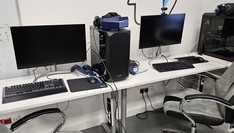Didactic and scientific laboratory, used by students and employees of the Faculty for the implementation of projects and diploma theses. Students have at their disposal dedicated Virtual Reality goggles and properly prepared computer equipment.
The tasks carried out in the laboratory include:
- modeling of objects using 3D programs,
- designing applications/games using virtual reality technology,
- designing applications using augmented reality,
- training courses in game programming conducted by students of Science Clubs.
The most important elements of the equipment include:
- 2 computer stations (Core i7, 512 GB SSD, 32GB RAM, MSI GeForce 2070, Windows 10),
- 1 computer station (Ryzen 5, 1TB SSD, 32GB RAM, Gigabyte GeForce 3060, Windows 10),
- 1 computer station (Ryzen 7 5800X, 32GB RAM, 2TB SSD, ASUS GeForce 3070, Windows 10)
- 1 computer station (Ryzen 7 5800X, 32GB RAM, 1TB SSD, MSI GeForce 3070, Windows 10)
- 1 computer station (Ryzen 9 5950X, 128GB RAM, 4 TB SSD, ASUS GeForce 3080Ti, Windows 10),
- 1 computer station (Ryzen 9 7950X, 64GB RAM, 4TB SSD, MSI GeForce 4070Ti, Windows 10),
- 2x VR HTC Vive,
- 1x VR HTC Vive Pro,
- 2x VR HTC Vive Pro 2,
- 2x VR HTC Pro Eye,
- 2x VR Valve Index,
- 1x VR Oculus Quest 2 64GB,
- 1x VR Meta Quest 2 256GB,
- 1x PiMax 5k Super,
- 1x VR HTC Focus 3
- 2x AR Microsoft Hololens 2,
- 1x HTC Vive XR Elite,
- 1x Meta Quest Pro,
- HTC Controllers,
- 1x HTC Face Tracker
- 1x HTC Wrist Band
- 2x Wireless HTC Adapter
- 3x Vive Tracker
- 4 signal bases fully compatible with SteamVR Tracking system (1.0 or 2.0),
- External lenses for eye tracking for HTC headsets
- Unity 3D and Unreal Engine version 4 and 5 software on each station,
- Blender software on each station,
- Visual Studio Code on each station.
Laboratory address:
Wincentego Pola 2,
building A, room A59








